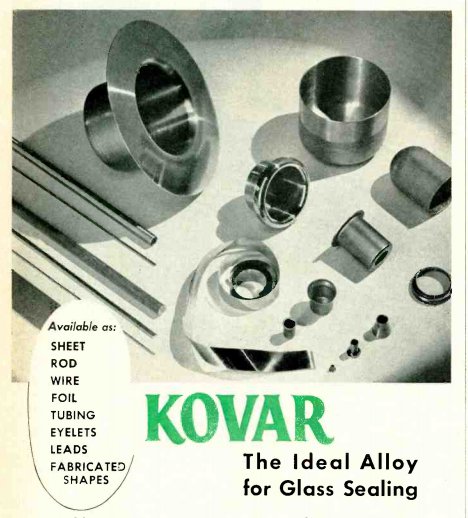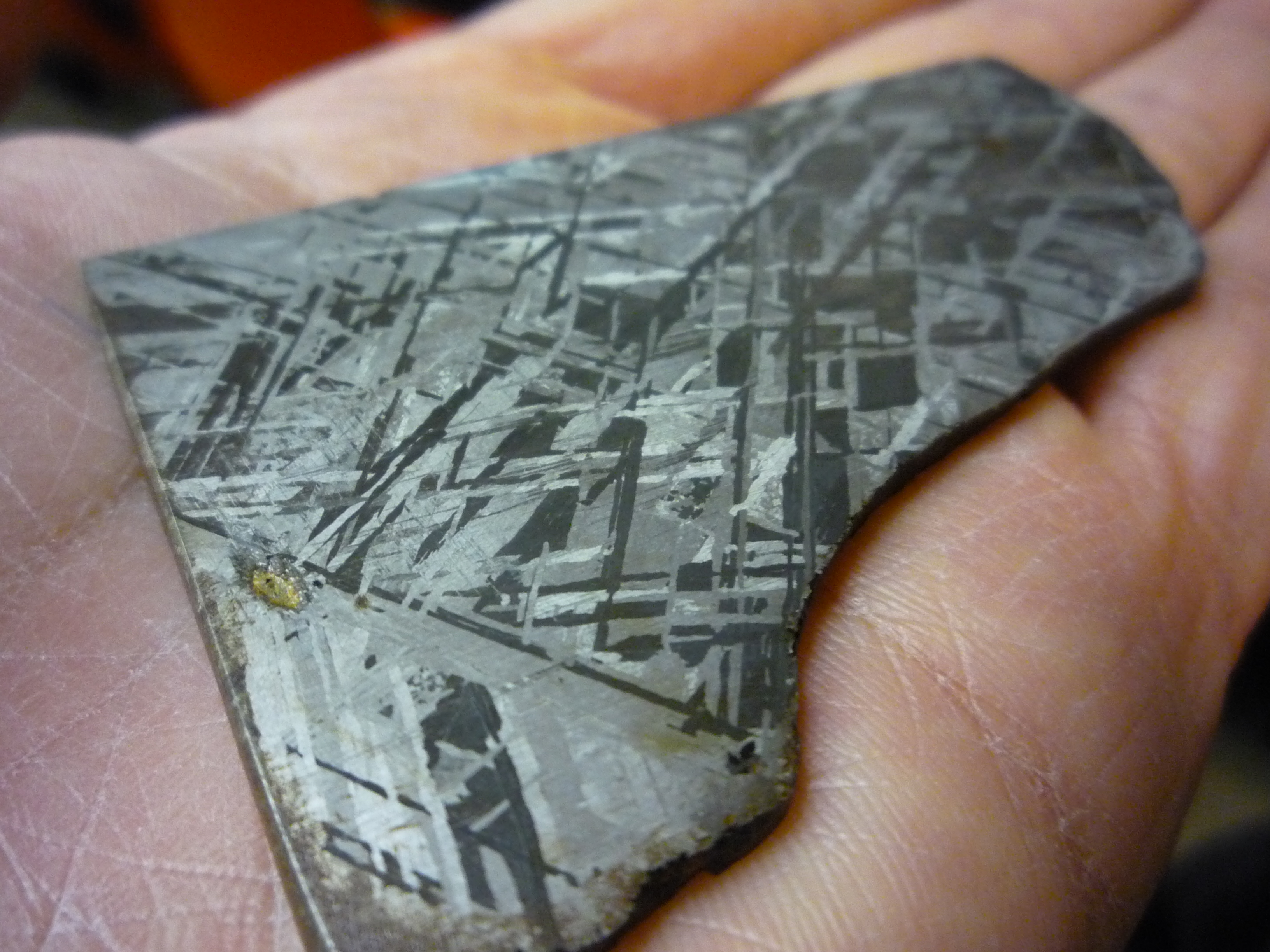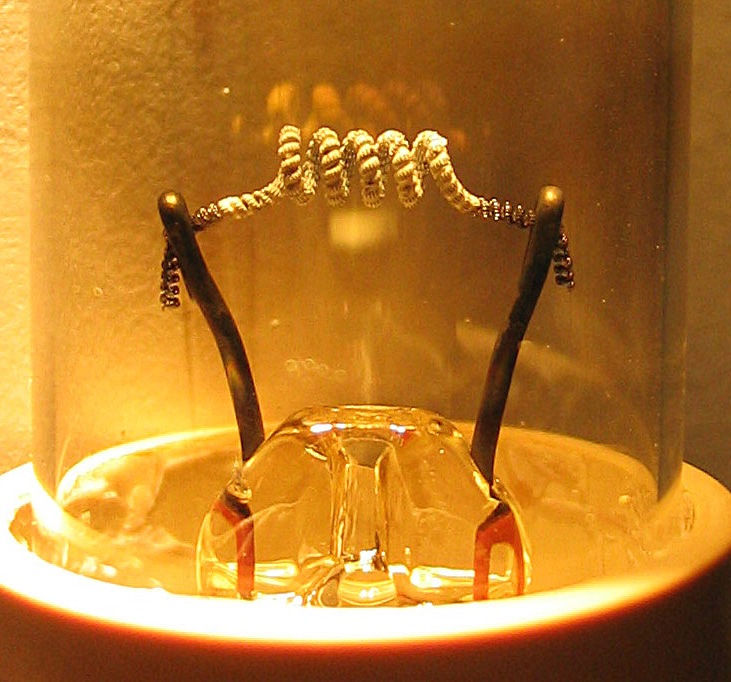|
Fernico
Fernico describes a family of metal alloys made primarily of iron, nickel and cobalt. The family includes Kovar, FerNiCo I, FerNiCo II, and Dumet. The name is made up of the chemical symbols of its constituent three elements. "Dumet" is a portmanteau of "dual" and "metal," because it is a heterogeneous alloy, usually fabricated in the form of a wire with an alloy core and a copper cladding. These alloys possess the properties of electrical conductivity, minimal oxidation and formation of porous surfaces at working temperatures of glass and thermal coefficients of expansion which match glass closely. These requirements allow the alloys to be used in glass seals, such that the seal does not crack, fracture or leak with changes in temperature. Dumet is most commonly used in seals where lead-in wires pass through the glass bulb wall of standard household electric lamps (light bulbs) among other things. The two Fernico alloys both consist of iron (Fe), nickel (Ni), and cobalt (Co). ... [...More Info...] [...Related Items...] OR: [Wikipedia] [Google] [Baidu] |
Kovar
Kovar (trademark of CRS Holdings, inc., Delaware) is a nickel–cobalt ferrous alloy compositionally identical to Fernico 1, designed to have substantially the same thermal expansion characteristics as borosilicate glass (≈ between , to ≈ at 800 °C) to allow a tight mechanical joint between the two materials over a range of temperatures. It finds application in glass-to-metal seals in scientific apparatus, and conductors entering glass envelopes of electronic parts such as vacuum tubes (valves), X-ray and microwave tubes and some lightbulbs. Kovar was invented to meet the need for a reliable glass-to-metal seal, which is required in electronic devices such as light bulbs, vacuum tubes, cathode-ray tubes, and in vacuum systems in chemistry and other scientific research. Most metals cannot seal to glass because their coefficient of thermal expansion is not the same as glass; as the joint cools after fabrication the stresses due to the different expansion rates o ... [...More Info...] [...Related Items...] OR: [Wikipedia] [Google] [Baidu] |
Cunife
Cunife is an alloy of copper (Cu), nickel (Ni), iron (Fe), and in some cases cobalt (Co). The alloy has the same linear coefficient of expansion as certain types of glass, and thus makes an ideal material for the lead out wires in light bulbs and thermionic valves. Fernico exhibits a similar property. It is a magnetic alloy and can be used for making magnets. Cunife has a magnetic coercivity of several hundred oersteds. Unlike most high coercivity magnetic materials which are hard and brittle and need to be cast into shape, cunife can be drawn into thin wires. Wires as thin as five thou can be produced this way. Thicker rods of the material can be threaded which is also something that is not possible with the more commonly used magnetic materials. In the early 1970s, Fender Musical Instruments Corporation used Cunife magnets in their Wide Range humbucker A humbucker, humbucking pickup, or double coil, is a guitar pickup that uses two wire coils to cancel out noisy ... [...More Info...] [...Related Items...] OR: [Wikipedia] [Google] [Baidu] |
Nickel
Nickel is a chemical element; it has symbol Ni and atomic number 28. It is a silvery-white lustrous metal with a slight golden tinge. Nickel is a hard and ductile transition metal. Pure nickel is chemically reactive, but large pieces are slow to react with air under standard conditions because a passivation layer of nickel oxide forms on the surface that prevents further corrosion. Even so, pure native nickel is found in Earth's crust only in tiny amounts, usually in ultramafic rocks, and in the interiors of larger nickel–iron meteorites that were not exposed to oxygen when outside Earth's atmosphere. Meteoric nickel is found in combination with iron, a reflection of the origin of those elements as major end products of supernova nucleosynthesis. An iron–nickel mixture is thought to compose Earth's outer and inner cores. Use of nickel (as natural meteoric nickel–iron alloy) has been traced as far back as 3500 BCE. Nickel was first isolated and classifie ... [...More Info...] [...Related Items...] OR: [Wikipedia] [Google] [Baidu] |
Ferrous Alloys
In chemistry, iron(II) refers to the element iron in its +2 oxidation state. The adjective ''ferrous'' or the prefix ''ferro-'' is often used to specify such compounds, as in ''ferrous chloride'' for iron(II) chloride (). The adjective ''ferric'' is used instead for iron(III) salts, containing the cation Fe3+. The word ''ferrous'' is derived from the Latin word , meaning "iron". In ionic compounds (salts), such an atom may occur as a separate cation (positive ion) abbreviated as Fe2+, although more precise descriptions include other ligands such as water and halides. Iron(II) centres occur in coordination complexes, such as in the anion ferrocyanide, , where six cyanide ligands are bound the metal centre; or, in organometallic compounds, such as the ferrocene , where two cyclopentadienyl anions are bound to the FeII centre. Ferrous ions in biology All known forms of life require iron. Many proteins in living beings contain iron(II) centers. Examples of such metalloproteins ... [...More Info...] [...Related Items...] OR: [Wikipedia] [Google] [Baidu] |
Copper-clad Aluminium Wire
Copper-clad aluminium wire (CCAW or CCA) is a dual-metal electrical conductor composed of an inner aluminium core and outer copper cladding. Production A copper strip is formed into the shape of a cylinder, while it is being wrapped around an aluminum core and the edges of the copper strip are welded together. The assembly is then pulled through a die, where the cladded wire is squeezed and stretched while also improving the bonding between the copper and the aluminum core. Uses The primary applications of this conductor revolve around weight reduction requirements. These applications include high-quality coils, such as the voice coils in headphones or portable loudspeakers; high frequency coaxial applications, such as RF antennas and cable television distribution cables; and power cables. CCA was also used in electrical wiring for buildings. The copper/aluminium construction was adopted to avoid some of the problems with aluminium wire yet retain most of the cost advantag ... [...More Info...] [...Related Items...] OR: [Wikipedia] [Google] [Baidu] |
Metaborate
A metaborate is a borate anion consisting of boron and oxygen, with empirical formula . Metaborate also refers to any salt (chemistry), salt or ester of such anion (e.g. salts such as sodium metaborate or calcium metaborate , and esters such as methyl metaborate ). Metaborate is one of the boron's oxyanions. Metaborates can be monomeric, oligomeric or polymeric. In aqueous solutions metaborate anion hydrolysis, hydrolyzes to tetrahydroxyborate . For this reason, solutions or hydrated salts of the latter are often improperly named "metaborates". Structure Solid state In the solid state of their Salt (chemistry), salts, metaborate ions are often oligomeric or polymeric, conceptually resulting from the fusion of two or more through shared oxygen atoms. In these anions, the boron atom forms covalent bonds with either three or four oxygen atoms. Some of the structures are: * A trimer with formula or , consisting of a six-membered ring of alternating boron and oxygen atoms with one ... [...More Info...] [...Related Items...] OR: [Wikipedia] [Google] [Baidu] |
Thermionic Valve
Thermionic emission is the liberation of charged particles from a hot electrode whose thermal energy gives some particles enough kinetic energy to escape the material's surface. The particles, sometimes called ''thermions'' in early literature, are now known to be ion source, ions or electrons. Thermal electron emission specifically refers to emission of electrons and occurs when thermal energy overcomes the material's work function. After emission, an opposite charge of equal magnitude to the emitted charge is initially left behind in the emitting region. But if the emitter is connected to a Electric battery, battery, that remaining charge is neutralized by charge supplied by the battery as particles are emitted, so the emitter will have the same charge it had before emission. This facilitates additional emission to sustain an electric current. Thomas Edison in 1880 while inventing Edison light bulb, his light bulb noticed this current, so subsequent scientists referred to the cur ... [...More Info...] [...Related Items...] OR: [Wikipedia] [Google] [Baidu] |
Light Bulb
Electric light is an artificial light source powered by electricity. Electric Light may also refer to: * Light fixture, a decorative enclosure for an electric light source * ''Electric Light'' (album), a 2018 album by James Bay * Electric Light (poetry) ''Electric Light'' (Faber and Faber, 2001, ) is a poetry collection by Seamus Heaney, who received the 1995 Nobel Prize in Literature. The collection explores childhood, nature, and poetry itself. Part one presents translations and adaptations, o ..., a poetry collection by Irish poet Seamus Heaney, 2001 * "Electric Light" (song), a 2008 song by Infernal {{disambig ... [...More Info...] [...Related Items...] OR: [Wikipedia] [Google] [Baidu] |
Manganese
Manganese is a chemical element; it has Symbol (chemistry), symbol Mn and atomic number 25. It is a hard, brittle, silvery metal, often found in minerals in combination with iron. Manganese was first isolated in the 1770s. It is a transition metal with a multifaceted array of industrial alloy uses, particularly in stainless steels. It improves strength, workability, and resistance to wear. Manganese oxide is used as an oxidising agent, as a rubber additive, and in glass making, fertilisers, and ceramics. Manganese sulfate can be used as a fungicide. Manganese is also an essential human dietary element, important in macronutrient metabolism, bone formation, and free radical defense systems. It is a critical component in dozens of proteins and enzymes. It is found mostly in the bones, but also the liver, kidneys, and brain. In the human brain, the manganese is bound to manganese metalloproteins, most notably glutamine synthetase in astrocytes. Manganese is commonly found in labo ... [...More Info...] [...Related Items...] OR: [Wikipedia] [Google] [Baidu] |
Silicon
Silicon is a chemical element; it has symbol Si and atomic number 14. It is a hard, brittle crystalline solid with a blue-grey metallic lustre, and is a tetravalent metalloid (sometimes considered a non-metal) and semiconductor. It is a member of group 14 in the periodic table: carbon is above it; and germanium, tin, lead, and flerovium are below it. It is relatively unreactive. Silicon is a significant element that is essential for several physiological and metabolic processes in plants. Silicon is widely regarded as the predominant semiconductor material due to its versatile applications in various electrical devices such as transistors, solar cells, integrated circuits, and others. These may be due to its significant band gap, expansive optical transmission range, extensive absorption spectrum, surface roughening, and effective anti-reflection coating. Because of its high chemical affinity for oxygen, it was not until 1823 that Jöns Jakob Berzelius was first able to p ... [...More Info...] [...Related Items...] OR: [Wikipedia] [Google] [Baidu] |
Carbon
Carbon () is a chemical element; it has chemical symbol, symbol C and atomic number 6. It is nonmetallic and tetravalence, tetravalent—meaning that its atoms are able to form up to four covalent bonds due to its valence shell exhibiting 4 electrons. It belongs to group 14 of the periodic table. Carbon makes up about 0.025 percent of Earth's crust. Three Isotopes of carbon, isotopes occur naturally, carbon-12, C and carbon-13, C being stable, while carbon-14, C is a radionuclide, decaying with a half-life of 5,700 years. Carbon is one of the timeline of chemical element discoveries#Pre-modern and early modern discoveries, few elements known since antiquity. Carbon is the 15th abundance of elements in Earth's crust, most abundant element in the Earth's crust, and the abundance of the chemical elements, fourth most abundant element in the universe by mass after hydrogen, helium, and oxygen. Carbon's abundance, its unique diversity of organic compounds, and its unusual abi ... [...More Info...] [...Related Items...] OR: [Wikipedia] [Google] [Baidu] |






